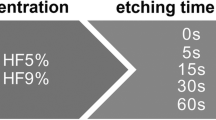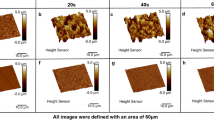Abstract
The aim of this study was to evaluate the effect of different surface treatments combined with laser irradiation on the shear bond strength of different CAD-CAM ceramics to composite resin. A total of hundred forty-seven ceramic specimens with thicknesses of 2.5 mm were prepared from three different CAD-CAM ceramics (an yttrium oxide partially stabilized tetragonal zirconia polycrystal (Y-TZP); a zirconia-reinforced lithium silicate glass ceramic (ZLS); and a lithium disilicate–strengthened lithium aluminosilicate glass ceramic (LD-LAS)) and subjected to seven groups of treatment (n = 7): (1) control (no treatment), (2) Er:YAG laser irradiation, (3) Nd:YAG laser irradiation, (4) etching with hydrofluoric acid (HFA), (5) Er:YAG + HFA, (6) Nd:YAG + HFA, and (7) sandblasting. After surface treatment procedures, a ceramic primer (Clearfil Ceramic Primer Plus, Kuraray, Japan) was applied to the ceramics. Bonding agent (Single Bond Universal Adhesive, 3 M ESPE, USA) was then applied, and the composite resin (Estelite Sigma Quick, Kuraray, Japan) was layered on the ceramic surfaces. The shear bond strength test was performed using a universal testing machine at a load of 0.5 mm/min. Data were analyzed by 2-way analysis of variance (ANOVA), and the Bonferroni correction was used for pairwise comparisons (α = 0.05). Compared to the bond strength of the control group, irradiation by Er:YAG and Nd:YAG lasers alone improved the bond strength of the composite resin to the Y-TZP (P < 0.001) but did not change the bond strength of composite resin to the ZLS and LD-LAS (P > 0.05). Compared to the bond strength of the control group, etching with HFA alone increased the bond strength of the composite resin to the ZLS and LD-LAS (P < 0.001) but did not affect the bond strength of the composite resin to the Y-TZP (P > 0.05). The highest bond strength of ZLS was obtained using HFA + Er:YAG, and the highest bond strength for LD-LAS was obtained using HFA + Nd:YAG. It was concluded that Er:YAG and Nd:YAG laser treatments presented the highest repair bond strength between the composite resin and Y-TZP ceramics. Er:YAG and Nd:YAG laser treatments in conjuction with HFA presented the highest repair bond strength between the composite resin and the glassy ceramics, ZLS, and LD + LAS.
Similar content being viewed by others
Data Availability
The dataset supporting the conclusions of this article is available upon request to the corresponding author, Elif Aydogan Ayaz.
References
Denry I, Kelly JR (2014) Emerging ceramic-based materials for dentistry. J Dent Res 93:1235–1242. https://doi.org/10.1177/0022034514553627
Al-Haj Husain N, Walther L, Özcan M, Brägger U, Joda T (2021) Effect of thickness and shade of resin and ceramic-based hybrid materials on color masking abilities and optical performance of CAD/CAM materials. Eur J Prosthodont Restor Dent 29:14–21. https://doi.org/10.1922/EJPRD_2058Al-HajHusain08
Turp V, Akgungor G, Sen D, Tuncelli B (2014) Evaluation of surface topography of zirconia ceramic after Er:YAG laser etching. Photomed Laser Surg 32:533–539. https://doi.org/10.1089/pho.2014.3730
Christel P, Meunier A, Heller M, Torre JP, Peille CN (1989) Mechanical properties and short-term in-vivo evaluation of yttrium-oxide-partially-stabilized zirconia. J Biomed Mater Res 23:45–61. https://doi.org/10.1002/jbm.820230105
Zarone F, Russo S, Sorrentino R (2011) From porcelain-fused-to-metal to zirconia: clinical and experimental considerations. Dent Mater 27:83–96. https://doi.org/10.1016/j.dental.2010.10.024
Akyil MS, Uzun IH, Bayindir F (2010) Bond strength of resin cement to yttrium-stabilized tetragonal zirconia ceramic treated with air abrasion, silica coating, and laser irradiation. Photomed Laser Surg 28:801–808. https://doi.org/10.1089/pho.2009.2697
Sato TP, Anami LC, Melo RM, Valandro LF, Bottino MA (2016) Effects of surface treatments on the bond strength between resin cement and a new zirconia-reinforced lithium silicate ceramic. Oper Dent 41:284–292. https://doi.org/10.2341/14-357-L
Ustun S, Ayaz EA (2021) Effect of different cement systems and aging on the bond strength of chairside CAD-CAM ceramics. J Prosthet Dent 125:334–339. https://doi.org/10.1016/j.prosdent.2019.11.025
Al-Haj Husain N, Sonderegger S, Özcan M, Brägger U, Joda T (2020) In vitro static and fatigue behavior of ceramic occlusal veneers using CAD/CAM. Eur J Prosthodont Restor Dent 28:113–120. https://doi.org/10.1922/EJPRD_2018Husain08
Gul P, Altınok-Uygun L (2020) Repair bond strength of resin composite to three aged CAD/CAM blocks using different repair systems. J Adv Prosthodont 12:131–139. https://doi.org/10.4047/jap.2020.12.3.131
Quinn GD, Giuseppetti AA, Hoffman KH (2014) Chipping fracture resistance of dental CAD/CAM restorative materials: part I–procedures and results. Dent Mater 30:e99–e111. https://doi.org/10.1016/j.dental.2014.02.010
Üstün Ö, Büyükhatipoğlu IK, Seçilmiş A (2018) Shear bond strength of repair systems to new CAD/CAM restorative materials. J Prosthodont 27:748–754. https://doi.org/10.1111/jopr.12564
Kumchai H, Juntavee P, Sun AF, Nathanson D (2020) Comparing the repair of veneered zirconia crowns with ceramic or composite resin: an in vitro study. Dent J (Basel) 8:37. https://doi.org/10.3390/dj8020037
Al-Turki L, Merdad Y, Abuhaimed TA, Sabbahi D, Almarshadi M, Aldabbagh R (2020) Repair bond strength of dental computer-aided design/computer-aided manufactured ceramics after different surface treatments. J Esthet Restor Dent 32:726–733. https://doi.org/10.1111/jerd.12635
Curtis AR, Wright AJ, Fleming GJ (2006) The influence of surface modification techniques on the performance of a Y-TZP dental ceramic. J Dent 34:195–206. https://doi.org/10.1016/j.jdent.2005.06.006
Amaral R, Ozcan M, Bottino MA, Valandro LF (2006) Microtensile bond strength of a resin cement to glass infiltrated zirconia-reinforced ceramic: the effect of surface conditioning. Dent Mater 22:283–290. https://doi.org/10.1016/j.dental.2005.04.021
Valandro LF, Della Bona A, Antonio Bottino M, Neisser MP (2005) The effect of ceramic surface treatment on bonding to densely sintered alumina ceramic. J Prosthet Dent 93:253–259. https://doi.org/10.1016/j.prosdent.2004.12.002
Blatz MB, Sadan A, Kern M (2003) Resin-ceramic bonding: a review of the literature. J Prosthet Dent 89:268–274. https://doi.org/10.1067/mpr.2003.50
Tanaka R, Fujishima A, Shibata Y, Manabe A, Miyazaki T (2008) Cooperation of phosphate monomer and silica modification on zirconia. J Dent Res 87:666–670. https://doi.org/10.1177/154405910808700705
Ulgey M, Gorler O, Karahan Gunduz C (2021) Effect of laser modalities on shear bond strength of composite superstructure to zirconia and PEEK infrastructures: an in vitro study. Odontology 109:845–853. https://doi.org/10.1007/s10266-021-00608-1
Kara O, Kara HB, Tobi ES, Ozturk AN, Kilic HS (2015) Effect of various lasers on the bond strength of two zirconia ceramics. Photomed Laser Surg 33:69–76. https://doi.org/10.1089/pho.2014.3841
Ataol AS, Ergun G (2018) Effects of surface treatments on repair bond strength of a new CAD/CAM ZLS glass ceramic and two different types of CAD/CAM ceramics. J Oral Sci 60:201–211. https://doi.org/10.2334/josnusd.17-0109
Cavalcanti AN, Foxton RM, Watson TF, Oliveira MT, Giannini M, Marchi GM (2009) Bond strength of resin cements to a zirconia ceramic with different surface treatments. Oper Dent 34:280–287. https://doi.org/10.2341/08-80
Usumez A, Hamdemirci N, Koroglu BY, Simsek I, Parlar O, Sari T (2013) Bond strength of resin cement to zirconia ceramic with different surface treatments. Lasers Med Sci 28:259–266. https://doi.org/10.1007/s10103-012-1136-x
Akın H, Ozkurt Z, Kırmalı O, Kazazoglu E, Ozdemir AK (2011) Shear bond strength of resin cement to zirconia ceramic after aluminum oxide sandblasting and various laser treatments. Photomed Laser Surg 29:797–802. https://doi.org/10.1089/pho.2011.3039
Moretto SG, de Freitas PM, Inca HEC, Cesar PF, Bello-Silva MS, de Paula EC (2021) Influence of Er:YAG laser surface treatment on flexural and bond strengths to glass-infiltrated zirconia-reinforced ceramic. Lasers Med Sci 36:1487–1495. https://doi.org/10.1007/s10103-020-03205-w
Viskic J, Jokic D, Jakovljevic S, Bergman L, Ortolan SM, Mestrovic S, Mehulic K (2018) Scanning electron microscope comparative surface evaluation of glazed-lithium disilicate ceramics under different irradiation settings of Nd:YAG and Er:YAG lasers. Angle Orthod 88:75–81. https://doi.org/10.2319/062017-408.1
Borges GA, Sophr AM, de Goes MF, Sobrinho LC, Chan DC (2003) Effect of etching and airborne particle abrasion on the microstructure of different dental ceramics. J Prosthet Dent 89:479–488. https://doi.org/10.1016/S0022-3913(02)52704-9
Lin Y, Song X, Chen Y, Zhu Q, Zhang W (2013) Effect of Er:YAG laser irradiation on bonding property of zirconia ceramics to resin cement. Photomed Laser Surg 31:619–625. https://doi.org/10.1089/pho.2013.3489
Altan B, Cinar S, Tuncelli B (2019) Evaluation of shear bond strength of zirconia-based monolithic CAD-CAM materials to resin cement after different surface treatments. Niger J Clin Pract 22:1475–1482. https://doi.org/10.4103/njcp.njcp_157_19
Kirmali O, Kustarci A, Kapdan A, Er K (2015) Efficacy of surface roughness and bond strength of Y-TZP zirconia after various pre-treatments. Photomed Laser Surg 33:15–21. https://doi.org/10.1089/pho.2014.3825
Cavalcanti AN, Pilecki P, Foxton RM, Watson TF, Oliveira MT, Gianinni M, Marchi GM (2009) Evaluation of the surface roughness and morphologic features of Y-TZP ceramics after different surface treatments. Photomed Laser Surg 27:473–479. https://doi.org/10.1089/pho.2008.2293
Author information
Authors and Affiliations
Contributions
Concept, S.Ü.A and E.A.A.; design, S.Ü.A.; supervision, E.A.A.; resources, S.Ü.A.; data collection and/or processing, S.Ü.A. and E.A.A.; analysis and/or interpretation, E.A.A.; literature search, S.Ü.A.; writing manuscript, S.Ü.A. and E.A.A.; critical review, E.A.A
Corresponding author
Ethics declarations
Ethical approval
Not applicable in this study.
Conflict of interest
The authors declare no competing interests.
Additional information
Publisher's note
Springer Nature remains neutral with regard to jurisdictional claims in published maps and institutional affiliations.
Rights and permissions
Springer Nature or its licensor (e.g. a society or other partner) holds exclusive rights to this article under a publishing agreement with the author(s) or other rightsholder(s); author self-archiving of the accepted manuscript version of this article is solely governed by the terms of such publishing agreement and applicable law.
About this article
Cite this article
Aladağ, S.Ü., Ayaz, E.A. Repair bond strength of different CAD-CAM ceramics after various surface treatments combined with laser irradiation. Lasers Med Sci 38, 51 (2023). https://doi.org/10.1007/s10103-023-03715-3
Received:
Accepted:
Published:
DOI: https://doi.org/10.1007/s10103-023-03715-3




